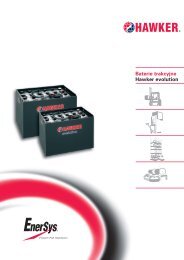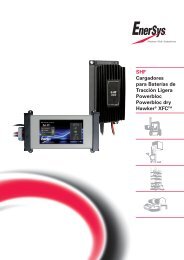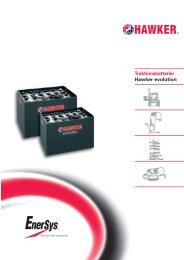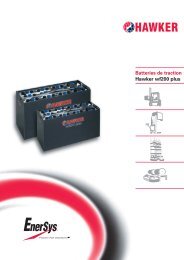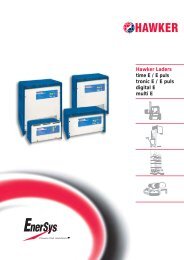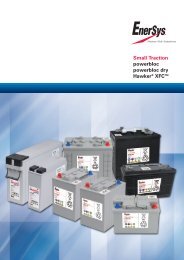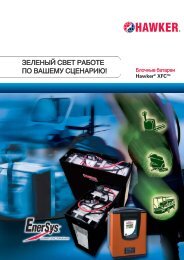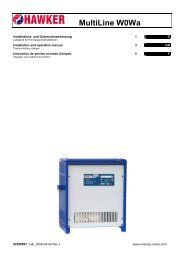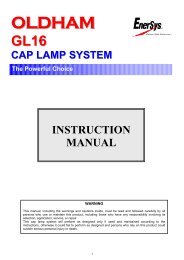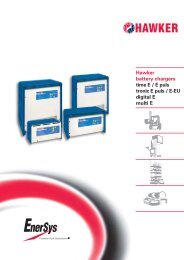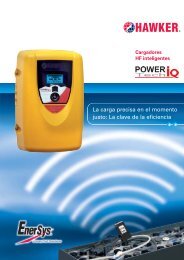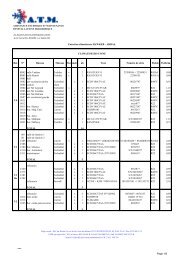16497 TH Hawker XFC gb - EnerSys-Hawker
16497 TH Hawker XFC gb - EnerSys-Hawker
16497 TH Hawker XFC gb - EnerSys-Hawker
Create successful ePaper yourself
Turn your PDF publications into a flip-book with our unique Google optimized e-Paper software.
STORAGE – HAWKER <strong>XFC</strong> BLOCS INSTALLED IN EQUIPMENT<br />
Some equipment will continue to draw very low power loads from the<br />
battery when not in service resulting in battery discharge rate greater<br />
than shown in figure 2 and described in the previous section. Con -<br />
sequently all sources of electrical power drain must be removed from<br />
the battery whilst in transit, storage or extended periods of time out of<br />
service. This includes disconnecting the Wi-IQ (if fitted) from the battery.<br />
Failure to comply with the above will result in premature battery failure.<br />
Also refer to comments in opportunity charging section relating to short<br />
storage periods between equipment usage.<br />
COMMISSIONING<br />
The <strong>Hawker</strong> <strong>XFC</strong> series monoblocs are supplied in a charged condition.<br />
The battery should be inspected to ensure it is in perfect physical<br />
condition.<br />
Check:<br />
1. The battery cleanliness. Before installing, the battery compartment<br />
has to be cleaned.<br />
2. All cables and crimped connectors are in good condition to<br />
support high electrical currents.<br />
3. The battery and cables have a good contact to terminals and the<br />
polarity is correct. Otherwise the battery, vehicle or charger could<br />
be severely damaged.<br />
4. Ensure that all insulation covers are fitted correctly.<br />
5. It is extremely important to ensure the integrity of battery<br />
connections. Soldered connections are preferred for battery plugs<br />
and post clamps. If soldering is not possible, multi-point crimping<br />
must be used.<br />
NOTE: Flexible cable or braid connectors must be used for all monobloc<br />
connections. Appropriate fastener kits must be used and approved<br />
parts. These can be supplied in <strong>EnerSys</strong> approved accessory<br />
kits. Integral to the fasteners system is an appropriate locking<br />
washer – spring or flat washers must not be used.<br />
Connectors must be adequately fastened (see table 3) with the locking<br />
washer in place to maintain contact integrity when exposed to<br />
operational shock/vibrations.<br />
Monobloc Terminal torque [Nm] Terminal torque [Nm]<br />
Type Standard Terminal Terminal Adapter<br />
12<strong>XFC</strong>25<br />
12<strong>XFC</strong>35<br />
12<strong>XFC</strong>48<br />
M6 Female 6.8 Nm SAE 6.8 Nm<br />
12<strong>XFC</strong>60 M6 Female 6.8 Nm SAE 6.8 Nm<br />
12<strong>XFC</strong>58 Not Not<br />
12<strong>XFC</strong>82<br />
12<strong>XFC</strong>158<br />
M8 Female 9.0 Nm applicable applicable<br />
12<strong>XFC</strong>177 M8 Female 9.0 Nm M6 Front Terminal 9.0 Nm<br />
Table 3 – Torque settings<br />
Use special coding systems for maintenance free batteries for the<br />
charging plug-and-socket devices to prevent accidental connection to<br />
the wrong type of charger. Never directly connect an electrical appliance<br />
(for example: warning beacon) to a part of the battery. This could lead to<br />
an imbalance of the cells during the recharge, i.e. a loss of capacity, the<br />
risk of insufficient discharge time, damage to the cells and VOIDS <strong>TH</strong>E<br />
BATTERY WARRANTY.<br />
Charge the battery before commissioning. Only blocs with the same<br />
state of charge should be connected together.<br />
The specified torque loading for the bolts/screws of the end cables and<br />
connectors are detailed in the table 3.<br />
OPERATION<br />
EN 50272-3 “Safety requirements for secondary batteries and battery<br />
installations. Part 3 traction batteries” is applicable to this product range.<br />
The nominal operating temperature is 30°C. The optimum lifetime of the<br />
battery depends on the operating conditions (temperature and depth of<br />
discharge). The ambient temperature range of use for the battery is between<br />
+10°C and +45°C, outside of this range must be approved by the<br />
<strong>EnerSys</strong> Technical department. Optimal battery life<br />
is obtained with the battery at a temperature of 25-30°C Higher tempe -<br />
ratures shorten the life of the battery (according to IEC1431 technical<br />
report), lower temperatures reduce the available capacity. The upper<br />
temperature limit is 45°C and batteries should not be operated above<br />
5<br />
this temperature. The capacity of the battery changes with temperature<br />
and falls considerably under 0°C. The optimum lifetime of the battery<br />
depends on the operating conditions (moderate temperature and moderate<br />
depth of discharge – e.g. 40-60% C 5). It is mandatory that the depth<br />
of discharge does not exceed 80% of the nominal C 5 capacity. Figure 5<br />
and 6 show relationship between depth of discharge and cycle life.<br />
The battery obtains its full capacity after about 3 charging and<br />
discharging cycles.<br />
OPERATING TEMPERATURE<br />
<strong>Hawker</strong> ® <strong>XFC</strong> TM batteries and <strong>EnerSys</strong> ® approved chargers are<br />
designed for use within an ambient temperature range of +10°C to<br />
+45°C. For use outside this range, you should consult with <strong>EnerSys</strong><br />
APPLICATION ENGINEERING AU<strong>TH</strong>ORITY. Applications outside the<br />
recommended temperature range will be considered but it will be<br />
mandatory to use an <strong>EnerSys</strong> charger with communication capability<br />
(Life IQ TM or Lifeplus) and the battery must be equipped with Wi-IQ ®<br />
monitoring device to manage the charge profile in accordance with the<br />
battery temperature.<br />
DISCHARGING<br />
The valves on the top of the battery must not be sealed or covered.<br />
Electrical connections (e.g. plugs) must only be made or broken in the<br />
open circuit condition. Discharges over 80% of the rated capacity are<br />
categorised as deep discharges and are not acceptable as they reduce<br />
considerably the life expectancy of the battery. Discharged batteries<br />
MUST be recharged immediately and MUST not be left in a discharged<br />
condition.<br />
Note: The following statement only applies to partially discharged<br />
batteries.<br />
Discharged batteries can freeze.<br />
Limit the discharge to 80% DOD. The presence of a discharge limiter is<br />
mandatory and cut-off voltage must be set at the value detailed in table 4,<br />
when discharging with currents in the range of I 0.5 to I 5. At lower<br />
currents please seek advice from the <strong>EnerSys</strong> Application Engineering<br />
Authority.<br />
Table 4 - Cut-off voltage limits<br />
Cut-off voltage setting [Vpc]<br />
60% DOD 1.96 V<br />
80% DOD 1.92 V



